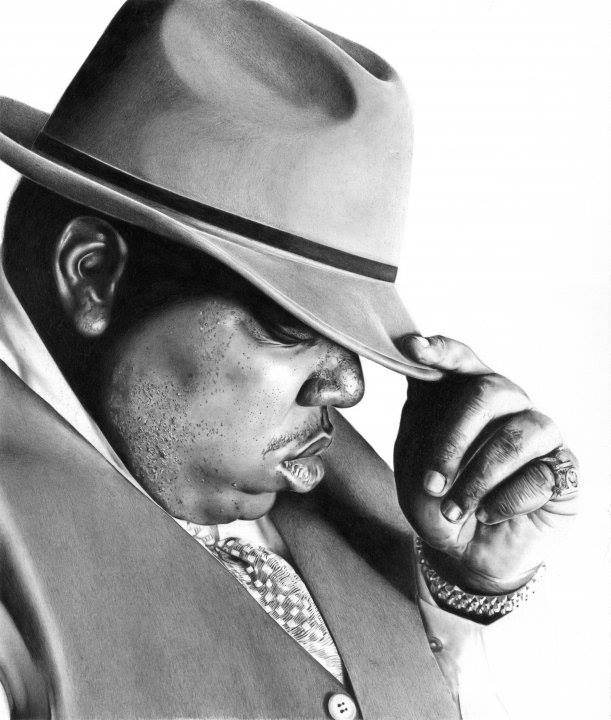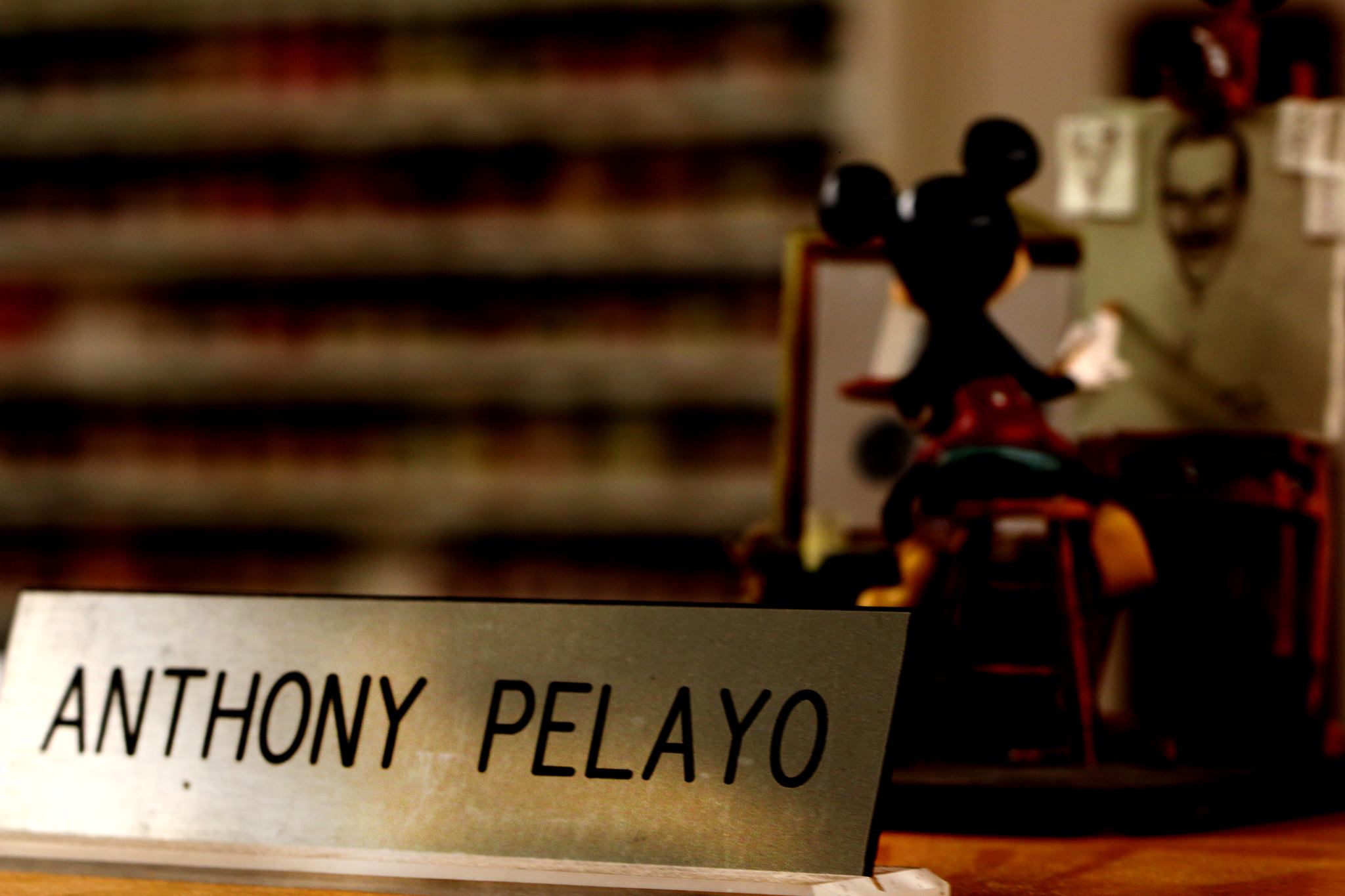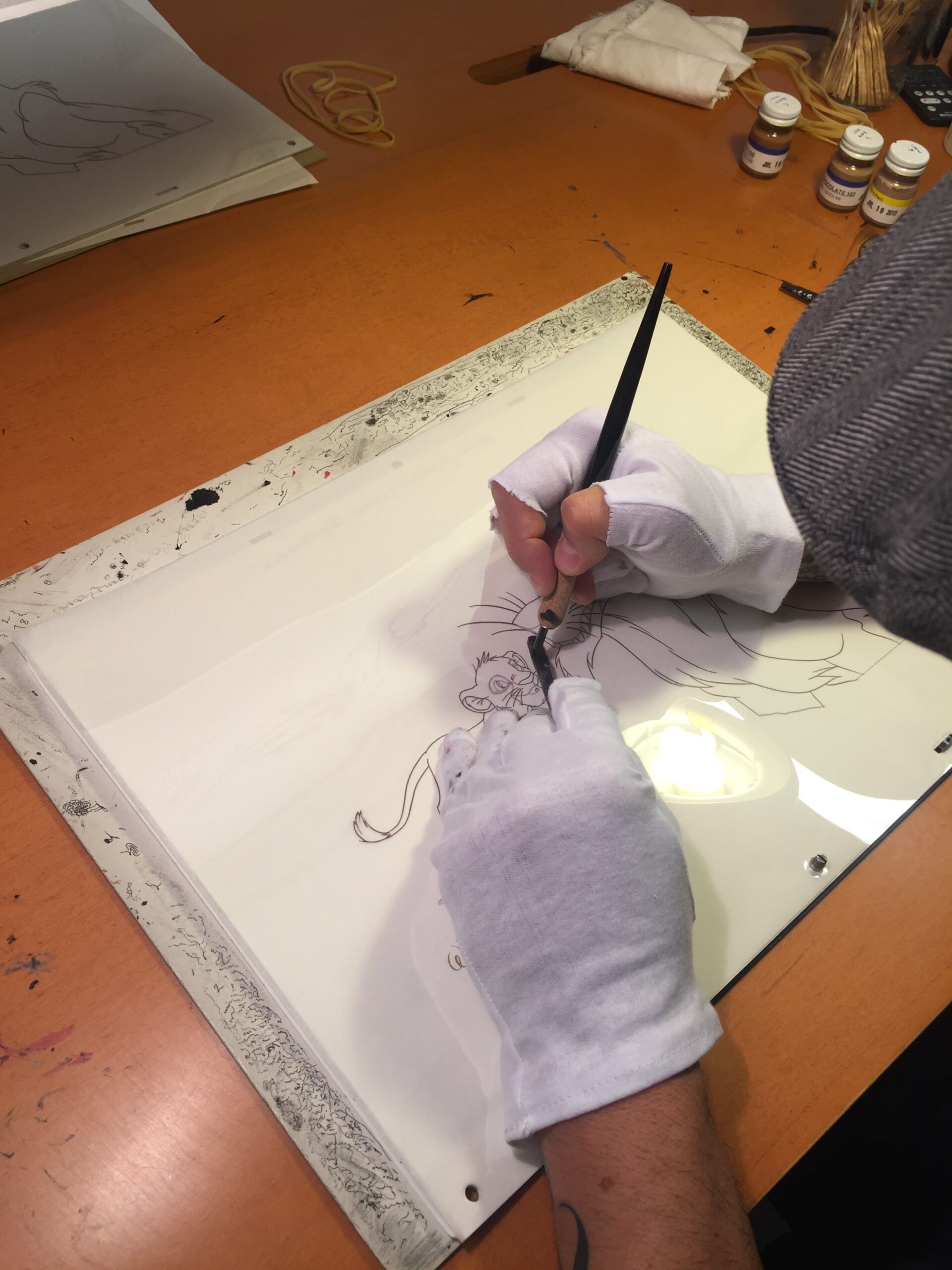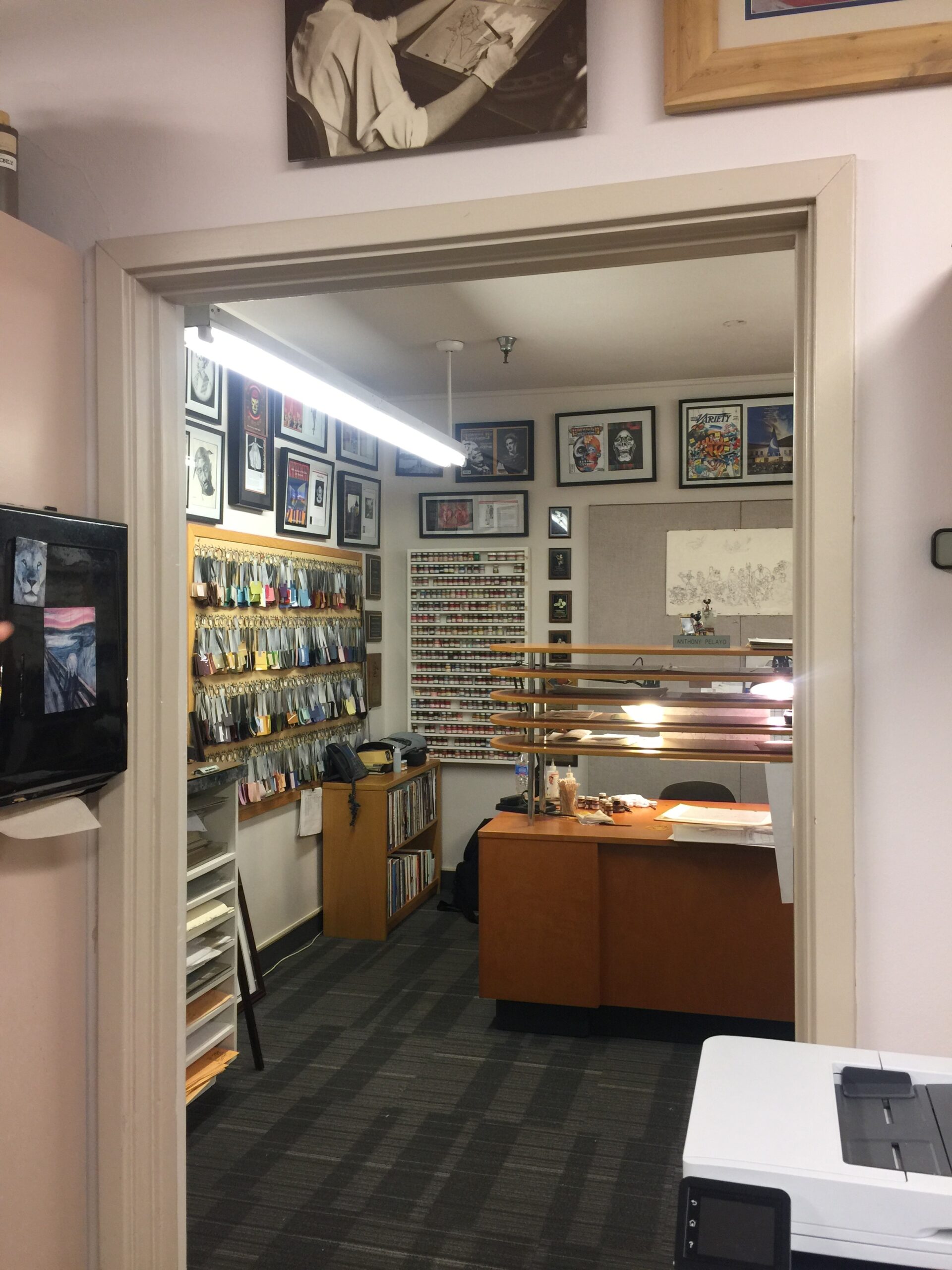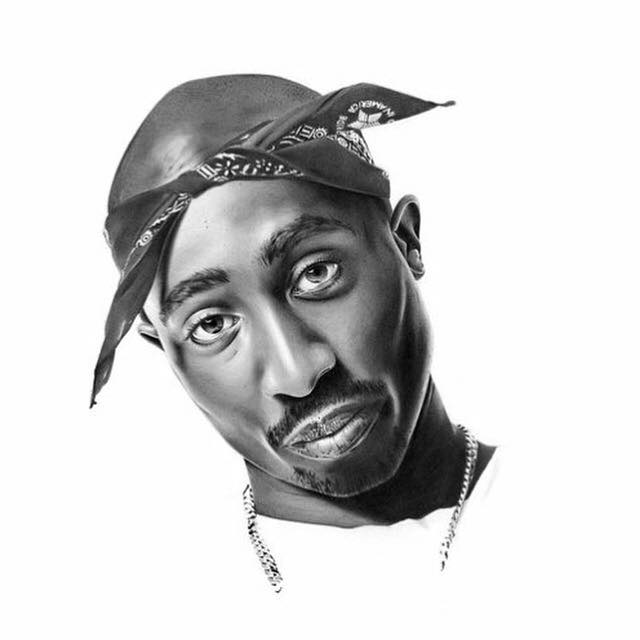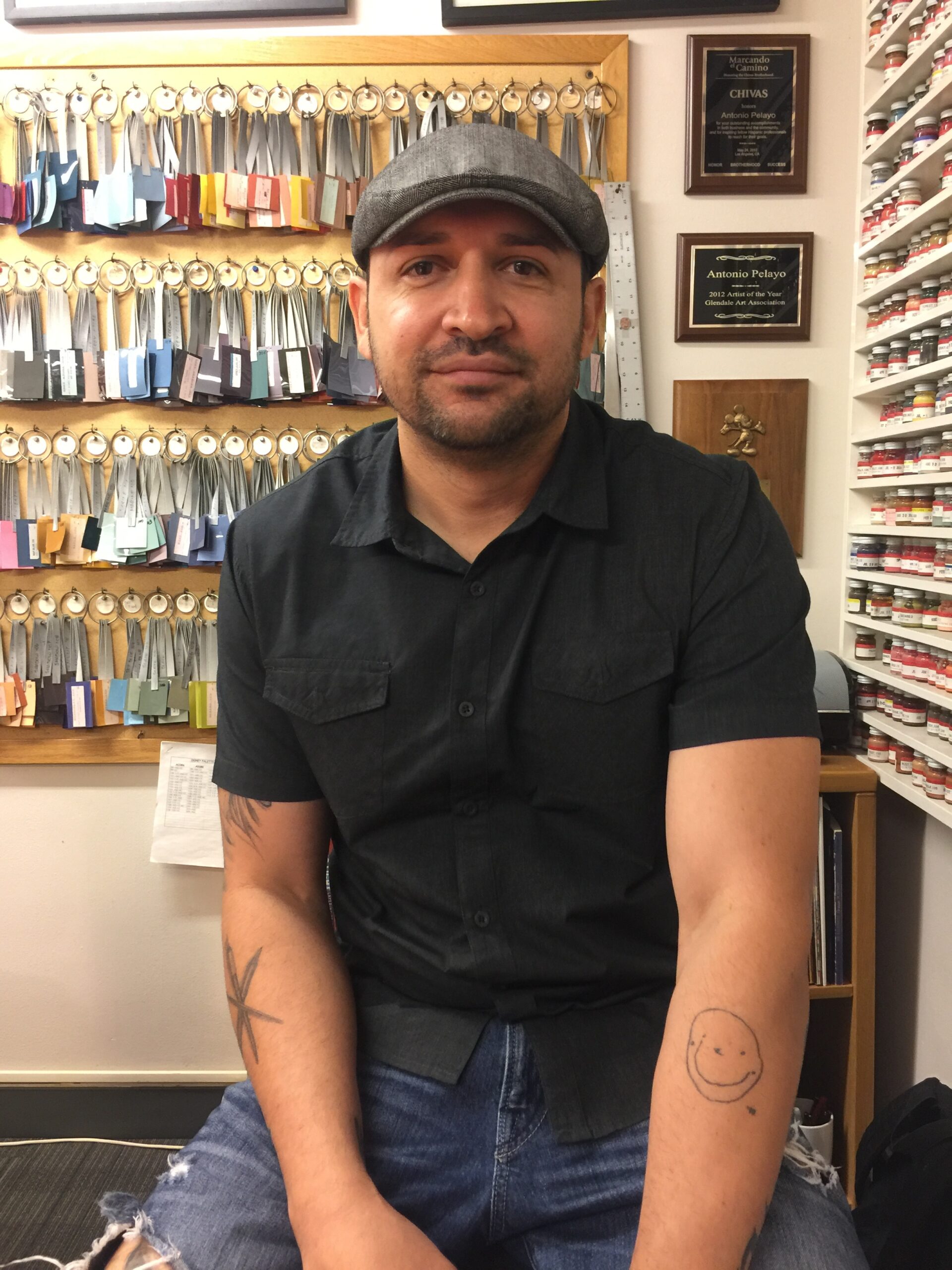Disney artist Antonio Pelayo on the importance of practice and how to make a living as an artist.
It was one of those Instagram posts that make you scroll back up and stare.
It was more real than real.
And it wasn’t done with a camera.
But with a pencil.
antoniopelayo.com
A pencil?!
I had never seen anything like it and I just had to know – who created such a thing?
The answer? Antonio Pelayo. He is a professional artist who has shown his work in over 200 shows to date. He also runs massive events in LA to showcase the artwork of others. Oh, he is also is considered the last Ink and Painter on the Disney Studio lot.
About a week after I moved to San Diego I hopped aboard the Pacific Surfliner train to Burbank to meet him at the animation studio Walt Disney built.
I wanted to know how Antonio got so good – what it takes to make the kind of art that stops someone in their tracks. I also wanted to know how he was making it as a professional artist.
And, to be honest, I also wanted to meet another Latino artist. There was something deeply inspiring about Antonio’s work and presence; it felt like he was breaking barriers somehow, making room, and I wanted to be in that room.
We meet at the corner of Mickey Avenue and Dopey Drive. Antonio walks me to his office in the Ink and Paint studio, and, surrounded by paints in every color, he tells me this is where very talented artists met with Walt Disney to work on movies like Bambi, Cinderella, and Fantasia.
As soon as we walk into his office I see the piece that first caught my attention and I zoom in real close. It’s even better in person.
Then I turn to his desk where I see a piece he’s working on of Simba. He shows me what it looks like to ink and paint a cel, the process used to make movies like the ones that were made here.
The process isn’t used anymore, but Antonio is keeping the art form alive for Disney – the pieces he creates are only available to Disney employees. Ink and Paint is no longer a part of the animation department but lives under the fine art umbrella now.
How did Antonio become the last ink and painter at Disney?
How did he also find time to also become an incredible professional artist in his own right?
How does he make a living as an artist?
How could you make a living as an artist?
Once Antonio finishes inking Simba’s ear, I find out.
1. Focus on getting really, really good
There are a lot of artists making a living who are not very good. You could try to skip this step and be one of those; but if you’re a Creative Teacup reader, that is not who you are.
You care about quality.
You care about the art more than the money. And definitely more than fame.
So this is the kind of artists living we’re talking about here – one that you can feel good about, one that doesn’t involve feeling icky or selling out. It’s the kind that is built on truly good work that has been honed over a long period of time.
Every artist I’ve ever admired put in that kind of work. They make a living from that work because they are able to hit a level of mastery very few reach – and not just because of the talent they were born with, but because of the time they put into honing it.
Antonio is one of those people.
He has been deeply practicing his art since he was in 4th grade. He grew up in California, but then he and his family moved to a small town in Mexico. The move was not great for Antonio’s social life, but it was very good for his ability to practice. “I had no friends so the only friend I had was drawing.”
For 10 years, Antonio drew in Mexico. For thousands and thousands of hours. We counted.
I ask him if it ever got boring, all the practice. He confirms that doing something you love is not always fun. “It would get boring for sure. You have thoughts like ‘I don’t know what the heck I’m doing. I don’t know where this is going. I don’t know if this is going to help me in the future.’”
So what kept him going? His dream of being a fine artist.
Dreams can be fantastic fuel to power you through the boring. Through the thousands of hours of practice required to get noticeably good at almost anything.
Thousands of hours of practice starts with just one. Do you have time set aside every day to practice your craft? Or at least every week? If not, make that a priority. (Or move to a small town where you have no friends.)
2. Ask for the job you want and say you’re an artist – like, out loud
Antonio also had another dream growing up: to work at Disney. “We used to live right around the corner from the Disney lot. I used to ride my bike around the lot and just imagine myself working here, visualizing myself working here, doing art.”
His plan was to go to college and then hopefully – one day – apply to Disney. The summer before college, to make some money, he worked at a temp agency.
One morning that temp agency assigns him to work at Disney. He worked in Art Classics and got to know everyone in the department. This was not the time to isolate himself like he did as a kid. There is a time for deep practice and then there is the time to talk to people (if you want to go pro, that is).
Through these friendships he found out that they were going to be starting a new inking department to repair some of the line work that was falling off the old cels.
So Antonio approached the boss of the department and asked if he could try out for the inking position.
“Are you an artist?” the boss asked.
“Yeah,” Antonio answered.
“Alright, come back tomorrow and we’ll have you take the test.”
And one Winnie-the-Pooh-inking-test later Antonio was the first one hired to this brand new department.
Inside Antonio’s office.
It’s one thing to practice your craft. It’s another to feel comfortable saying, I am an artist, or I am a writer, or I am a [insert your thing here]. Some people have no problem owning this. For others, it’s just not so easy.
But there comes a time where no one will give you an opportunity unless you can claim your own artistry – unless you can fully own it – out loud. It doesn’t mean you always have to believe it (we all have our bad, self-doubty days). It just means you need to believe it long enough to answer the “Are you an artist?” question in the moment with a “Yes” – or even a “Yeah.”
And while you’re feeling brave, why not ask for the job you want? If they say no, ask someone else. Or ask again later. Or keep getting really really good and then ask again.
3. Notice what blows you away
Antonio did not see his first art show until he was 23 years old. There are dreams in your life you simply cannot have until you’re exposed to them.
Disney held art exhibitions and Antonio clearly remembers the first one he ever saw. “I was blown away.”
He was just amazed at the concept of an art show. “So you can create art and then you hang it on the wall and people come and either admire it?!” he remembers thinking at the time.
He is hooked.
A new dream is born.
And years later, his work is on the wall at a Disney art show.
4. Show your work (to people you trust)
Antonio continued to get to know the artists around him, and one became his mentor – a person Antonio trusted enough to show first drafts of his work. “I would draw something and bring it to him and he’d say ‘alright do this’ or ‘do that.’” He gave Antonio feedback, little tweaks, and Antonio made changes based on his feedback.
He kept going.
He kept getting better.
He kept drawing different things – whatever inspired him.
One day, he started to draw eyes – he was fascinated with the eyes – and the eyes turned into a full portrait. When he showed that to his mentor, he got a lot of positive feedback. Other people ended up seeing it too and the positive feedback kept coming.
“I got super motivated and I just continued doing that.”
That’s how he got started with portraits.
antoniopelayo.com
There are some people who say you don’t need motivation – that motivation is for amateurs. I think that’s something only people who’ve already gotten a healthy dose of encouragement and motivation say.
You can’t wait around every day for some kind of “magical motivation” to inspire you to do your creative work, that’s for sure – but that doesn’t mean motivation isn’t crucial. (It’s always been vital for me to build motivation into my life, into my house even; I have quotes from my favorite artists on my walls. There is a J.K. Rowling quote I stare at every day.)
I can’t help but wonder if kids who “aren’t motivated” simply haven’t found what they’re good at or haven’t been given the environment to flourish, to really get good at something. While I’m sure there are plenty of “unmotivated” people who were over-praised, I fear we too broadly chastise the “unmotivated” when really they just haven’t had the luxury of that moment where they could taste their own worth.
And if you are part of an underrepresented group in your field, well, this is an even bigger hill to climb.
But it can be climbed. (The #keepgoingclub and free course are here to help with that!)
5. Show up before you have any clue what you’re doing
Antonio kept doing and sharing his art. For years. And sometimes someone notices (it almost always takes longer than you think, I find. That part when it feels like no one notices is painful. But everyone goes through it. You’re in good company.)
In this case, it was the famous graffiti artist, Retna.
When you focus on your craft, focus on iteration, focus on getting really really good, eventually other really really good people will start to notice.
Retna wanted to buy Antonio’s original Tupac drawing.
antoniopelayo.com
Antonio wasn’t actually selling it though. But at the time Retna was also putting on exhibitions and instead invited Antonio to exhibit 10-15 pieces.
“I was so not ready to start exhibiting like that,” Antonio remembers.
But he said yes anyway.
It became his first official show at a real art gallery, and it began his art career; to date he has done over 200 exhibitions.
And he started before he was ready.
6. Remember that rejection and criticism are evidence you’re doing something right
I ask Antonio if he remembers what it was like the first time he saw his art up on a wall for others to see. “It felt amazing,” he remembers. But then he begins talking about the anxiety and the stress that sets in, wondering “Are people going to like it?”
I ask him if he remembers the compliments. He laughs and replies that no, he doesn’t.
“I do remember the negative ones.” Unfortunately, sometimes those are the ones that stick.
But Antonio never let them stop him, and he owes that to his pro mindset: “You have to develop that entrepreneurial mindset that there’s rejection – not everybody’s going buy your stuff. Maybe one out of ten people might agree with you; that’s just part of it. And it’s the same thing with art. You create a product and not everyone is going to love it, and some people are going to give you negative feedback.”
Most of the time, Antonio just moves on from the feedback. But sometimes, it can cause even the best artists to spiral with thoughts of quitting: “Maybe I’m not doing the right thing. Maybe I should quit. Maybe my work is not good enough…”
I’ve yet to meet the professional artist who says these thoughts don’t come, who says it doesn’t sting. It always does.
But what artists like Antonio learn how to do is cut down the time these thoughts are allowed to linger. Because he knows that they can be dangerous: “I try not to get attached to those thoughts. Because if you do you’re done.”
I ask him how he detaches from them.
He reminds himself that this is part of it – part of the dream. Part of being a professional. An unavoidable part, in fact.
Negative feedback is also a sign that you’re no longer hiding – your art is on the wall. You’ve taken a leap so few people actually do in the grand scheme of things. And that is something to celebrate.
7. Combine technique with your unique story
Almost every professional artist I’ve ever talked to or read about began by imitating masters. There is so much to be learned, and it is worth taking the time to learn it, even if you’re not doing anything “original” right away.
But at some point, if you want to become a professional artist, if you want to make money with your art, you have to begin to share your own voice.
Your own voice is your secret sauce. The twist that can change everything.
Antonio started by drawing portraits of icons. “But in the art world it’s not really considered ‘art’ unless you put a twist on the portraits. I did 20 pieces, but I still really didn’t know what I was doing.”
Antonio still hadn’t found his voice.
It takes a while.
But he kept creating – and that is what made all the difference. He kept showing his art, over and over and over again, even before he was ready, even before he found his voice, and that led to him getting picked up by an art gallery in Pasadena that wanted to represent him. Through that, he got a mentor who started helping him find his artistic voice.
“I learned that as an artist you have to tell a story. If I draw a bunch of celebrities, what story am I telling? I’m not telling any story, I’m just putting out my technical skills.”
Putting out his technical skills still mattered, though. It got him to this gallery, to that mentor, and to the person who encouraged him to draw his story.
It was after this that Antonio did his 13-piece series documenting his family’s migration to Mexico.
antoniopelayo.com
This was the series that first put Antonio on my radar. This was the series that stopped me in my tracks. This was when I knew I had to reach out.
With just a drawing, there was a story, one I related to on a deep level.
All art is storytelling. And the best story you have to tell is your own.
It’s also the story that can turn you pro.
8. Remember the positive effect your work can have
But for Antonio, making money with his art has never been the goal. In fact, there are a lot of ways to make a living as an artist.
Antonio is doing both; his day job and his art contribute to his living.
But what being a professional artist means to him, in addition to taking his “hobby” really seriously in his early days, is a sense of responsibility – not only for taking care of his family, including his son who is also an artist, but also a responsibility to the people looking at his art on the walls, and to those who dream of putting theirs up too – especially those who feel unseen.
“I’ve seen what happens when you get your work out there and it inspires a lot of people, and it moves them. When that happens I think there’s a level of responsibility to continue doing it.”
Antonio now does what Retna did for him; he encourages lots of young artists to begin showing their work through curating his annual events in Los Angeles which have become incredibly popular and have helped other artists launch their careers.
“Art moves people and it changes lives. I’ve seen what art has done for me. And I’ve seen what it’s done for a lot of people, especially my son.”
Antonio smiles as he remembers how he gave his son a sharpee and a piece of paper when he was four years old and how he drew a big circle with two eyes.
What Antonio did next surprised and delighted me more than anything in any other interview ever has:
He rolled up his sleeve and showed me the tattoo he has of his son’s first drawing.
He has the original at his house, framed.
I think of my favorite children’s book, The Dot, about what happens to a young girl who ‘can’t draw’ after her art teacher frames her first drawing attempt. I think about how special it is to frame art, how much more we need to be telling each other how precious and wonderful our creations are, especially in such a sea of negative online feedback.
We need to all proverbially tattoo each other’s art on our faces.
We need to keep each other going. Because for any artist trying to making a living – whether it’s in their day job or in their own business or both – there will always be down times; there will always be scary, uncertain times.
There will always be negative feedback.
But the responsibility you have as an artist is not to the critics. It’s not to the money or the market. It’s to the people who love your work, even if for a long time that’s only a very small handful of people.
9. Chose the professional artist path that’s right for you
So which path is right for you to make a living with your art? There are so many ways to do it, and I’ve found different things work for different people at different times; a couple include:
-
Non-artistic day job + art on the side
-
Pros: You don’t put financial or market pressure on your art. You don’t force your creativity to make you money. It gives it room to breathe, and gives you time to find your voice. You also don’t use your creative energy at your job so you have more to spare when it’s time for your art.
-
Cons: You might feel bored not using your artistic self at your day job; you might feel like you’re wasting time not getting better, or you might feel like you don’t have enough time to dedicate to your art.
-
-
Art full-time (no day job)
-
Pros: You are able to focus 100% on getting great and doing your art. You can accelerate your progress because of all the time you have to focus and create. There is a fire under you. You have no other option but to make this work.
-
Cons: You put pressure on your art to pay your rent, and sometimes that can mean getting very stuck, beginning to hate a thing you used to love, or can cause you to end up having to take on clients you don’t want or do administrative work required to have your own business that you may hate. It can also be emotionally exhausting for work you care deeply about to be a business; you have to get REALLY pro at separating your personal worth from your art and business.
-
-
Artistic day job + art on the side
-
Pros: You feel like a full-time artist all the time. You’re able to do the art you love the most on the side without any pressure. It remains fun, joyful, and it gives you lots of space for your voice to shine. You also create awesome stuff in your day job which makes you not feel guilty when there are seasons where you may not have as much time for your personal art or you may need to take a break to refresh.
-
Cons: You may feel like you use all your creative energy at your day job and then have nothing else for your art. You may get too comfortable in your artistic day job and lose the hunger to pursue your art professionally (if that is your goal).
-
There is no right answer. And there is no one scenario that works all the time. It depends on you, your goals, and your priorities. And all of those may change! The only way to really know the best one for you at any given time is to experiment. You can also read about and talk to people who have done the same. Find out what sounds like you.
To start, when you read the pros and cons, which cons sounded the most “worth it” to you? Or at the very least worth the risk? That’s when you know that’s probably your dream option right now.
Right now Antonio makes his living as an artist in his day job and in his own artistic career. He loves it. It’s perfect for him. “It helps because I never get to the point where I think about quitting; I’ve always had a job, so I didn’t have to rely on my artwork to survive.”
And in case you’re wondering, Antonio has been in a position where he could have easily quit his day job and financially supported himself with his art.
But for him, for now, this is the path that helps him flourish best and be the kind of artist he wants to be, including the kind of artist who provides for his son.
His son aspires to be a full-time artist, and as you can probably guess, Antonio supports that completely. “You always hear people saying that their parents didn’t want their kid to be an artist. ‘Get a real job, there’s no money there.’ Which is kind of true. It’s not easy to make money in the art world.”
But being a professional artist to him is about more than making money. It’s about taking it seriously. Showing up.
And not just with a pencil.
“When my grandfather Juan died, 5,000 people showed up to his funeral in El Grullo, Mexico.”
His father was not a “Great Artist.” But then again, it depends on how you define it.
“People would go to his house and he would take them in, feed them, give them money, not a lot, but he gave them what he had.”
To give what you have. That is what an artist is to me. And that is how you can find a way to make a living – one that works for you and your family. Give what you have. Keep going.
10. Find the thing that will sustain you for 12 years
But what if your dream is to be a full-time professional artist? To do the thing all the time? What if that is the thing that fits you best?
How do you do it?
And how long does it really take?
Every industry varies, and the best way to find out is to research more about the artists who most closely represent who you want to be. Find out how long it really took them until they were making a living with their art – and how young they started (not that you miss your shot if you don’t start young, but you want to make sure you have a realistic understanding of how many years they have been practicing). This is the best way to get a realistic picture of what it actually takes. It can sometimes be a little depressing when you realize how many years may be required, but I actually find it provides me with more relief and #keepgoingpower than anything else.
For example, one day when I was super bummed (read: crying on a rug) that the book I thought would only take me one year was already in its third year, I came across an article about how it took Lin-Manuel Miranda six years to write Hamilton, and I breathed a sigh of relief. Lin-Manuel is a literal MacArthur Genius and even he didn’t just spill Hamilton out in a couple months, or even a year.
To make a full time living as a fine artist, showing our art in exhibitions, Antonio says it takes about 12 years.
Not just 12 years of hoping. But 12 years of showing your art, practicing for hours every day.
And even then, there is no guarantee: “As an artist it takes about 12 years to break in, and a lot of times you don’t even break in. So I knew going into it that I was entering a world where I wasn’t going to be making any money. There’s been some struggling in between, but I love it.”
Antonio loves art. He loves drawing.
This is what sustains him. This is what keeps him practicing. While making a living at it is great, what he cares about more is doing the art and putting it up on the wall (or sharing others’ art on the wall). I’ve found that to be true of almost all the professional artists I love the most.
They take it seriously as a professional and do the hard work and daily rituals required to become really, really good. But they also love it. Like, really love it.
Like, so much so, that they can’t not do it.
That’s what Don Hahn said to me once (fun fact: Don is also the producer of Lion King, which Antonio was inking when I walked in): That you know you’re a writer when you can’t not write. You know you’re an actor when you can’t not act. You know you’re an artist when you can’t not make your art. It doesn’t mean there aren’t seasons where you aren’t doing the thing. But when there are, you don’t like it. Something feels very wrong, and you itch to do your thing again.
There are so many ways you can make a living as an artist, and they all begin with knowing what kind of artist you are and what craft you care about so much that you want to do it almost all of the time – even when it doesn’t do a single thing to provide you with a financial living. That, right there, is actually the thing that just might help you make a living as an artist.
Because when you put in more hours, more focus – when you just can’t stop (meaning even when you do stop you always come back) – then you have a chance of outlasting and out-practicing everyone else.
You have a chance at becoming so good that people can hardly believe what they are seeing, reading, experiencing. It feels like magic.
It feels more real than real.
It transports people.
And even if it doesn’t ever make you a dollar, it might make 5,000 people show up to your funeral to say thank you for giving what you had.
Inspired by Antonio? You can follow him on:
Instagram: @antoniopelayo
Twitter: @antonio_pelayo
Facebook: anontiopelayoart
The Little Book of Big Dreams is filled with true stories of dreamers who decided to try for their biggest dreams and kept going when things got hard (which they almost always do).
The dreamers in this book include Oscar winner Kristen Anderson-Lopez, Disney producer Don Hahn, Pensole Lewis College founder D’Wayne Edwards, Hamilton cast member Seth Stewart, Black Girls Code founder Kimberly Bryant, and more.
But the most important story in this book is yours.
The Little Book of Big Dreams: True Stories about People Who Followed a Spark
ORDER THE LITTLE BOOK OF BIG DREAMS
SPARK YOUR NEXT DREAM
© Chronicle | Legal | Site Credit |
